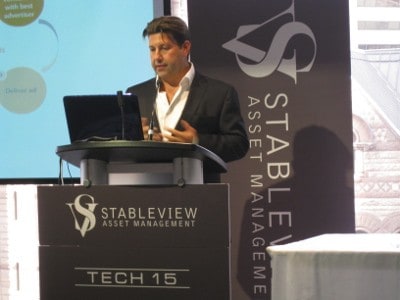

Toronto-based ad tech company AcuityAds (TSXV:AT) presented at StableView Asset Management’s TECH 15 conference on Wednesday, represented by CEO Tal Hayek, who answered investor questions after his presentation.
“In the future, TV is not going to be delivered through cables, but will be delivered in a more digital way,” Hayek told a room full of Bay Street investors and analysts, which sounds like stating the obvious but it is an acknowledgement that is still remarkably early days for that transition, despite all the froth around the ad tech sector.
The initial wave of hype ushering in the ad tech industry over the past several years has been replaced by a cold bath of skepticism, with venture capital drying up for privately held ad tech companies relative to other tech sector verticals and the markets actively punishing the stocks of publicly traded ad tech firms.
Why then is AcuityAds defying gravity as its quarterly revenues rose 43% year-over-year to $4.6 million and its quarterly EBITDA reduced 66% from $1.4 million in negative territory to $488,000, according to its Q2 earnings report?
“Almost nobody in the ad tech space makes money,” said Hayek. “And we’re very proud to announce that we’ll be there soon. We’re not there yet, but we’re very, very close. In the next few quarters, we will be EBITDA positive.”
The digital marketing landscape is a $45 billion market, growing 20% per year. So there’s a strong last-person-standing case to be made that as competitors are weeded out, either through failure or acquisition by larger companies, that the companies who remain will benefit most from what until now has been a struggling industry.
The overall advertising market stands at $490 billion US, showing how niche digital marketing still is.
“We’re moving from a $45 billion market opportunity to a $490 billion market opportunity with the right technology to take us there,” said Hayek, indicating that he believes that ad tech will see mainstream adoption.
Meanwhile, Acuity needs to grow in order to compete.
“We are in the market now looking for acquisitions,” says Hayek, adding that “Most of these companies don’t develop their own technologies, but license existing solutions,” making it fairly easy to determine which companies offer most value for an acquirer.
The company also continues its aggressive expansion into the U.S. market, and continues to meet demand for its SaaS programmatic platform, both factors contributing to Acuity’s spending on growth.
Sales for the self-serve platform, launched over a year ago, were up from only $300,000 in Q2 2014 to $1 million in the same quarter this year.
In a space as competitive as ad tech, companies are also required to feed the need to innovate.
“About a third of our force is dedicated to research and development,” added Hayek, “so we’re always going to keep developing our product.
AcuityAds IPO’d in June 2014, led by Paradigm Capital and Beacon Securities.
One of the benefits of a publicly traded company is that the financials are transparent, and investors can actually see how a company is doing.
While a lot of ad tech companies who appeared to be doing well because of the billions dumped into the sector by advertisers, recent events have starkly unveiled programmatic advertising’s underwhelming performance.
Some of the ad tech backlash is driven by confusion on the part of investors over what qualifies as an ad tech company, with some companies offering full agency services while others participate in the programmatic or real-time bidding (RTB) ad exchange market.
And some of the backlash is fueled by the discovery that a lot of ad tech is not what it’s cracked up to be, with a fair amount of it bordering on outright fraud, not to mention statistical evidence that traditional media provides significantly greater return-on-investment compared to stubbornly low returns from ad tech.
So how has AcuityAds made good on all of the buzzwords that other less stellar ad tech companies have recently diminished, such as “machine learning”, real-time bidding and Big Data?
With their proprietary Programmatic Marketing Platform, have they simply figured out the promise of ad tech that so many other firms have struggled to unlock?
Hayek suggest that yes, whereas competitors refresh their data sets every three hours, Acuity has managed to figure out a way to refresh its system approximately every minute, giving it a clear advantage over its competition.
He also claims that Acuity has managed to almost eliminate fraudulent traffic from its platform, which has otherwise sullied the ad tech space as a whole.
Another vehicle for growth and revenue is that Acuity has split its offering between managed services, in which an advertiser allows AcuityAds complete execution of an ad spend, and self-serve, in which an advertiser creates and manages their own campaign using the AcuityAds platform.
According to Hayek, the self-serve platform is growing Acuity’s topline revenue without greatly increasing its expenses.
Leave a Reply
You must be logged in to post a comment.




 Share
Share Tweet
Tweet Share
Share




Comment